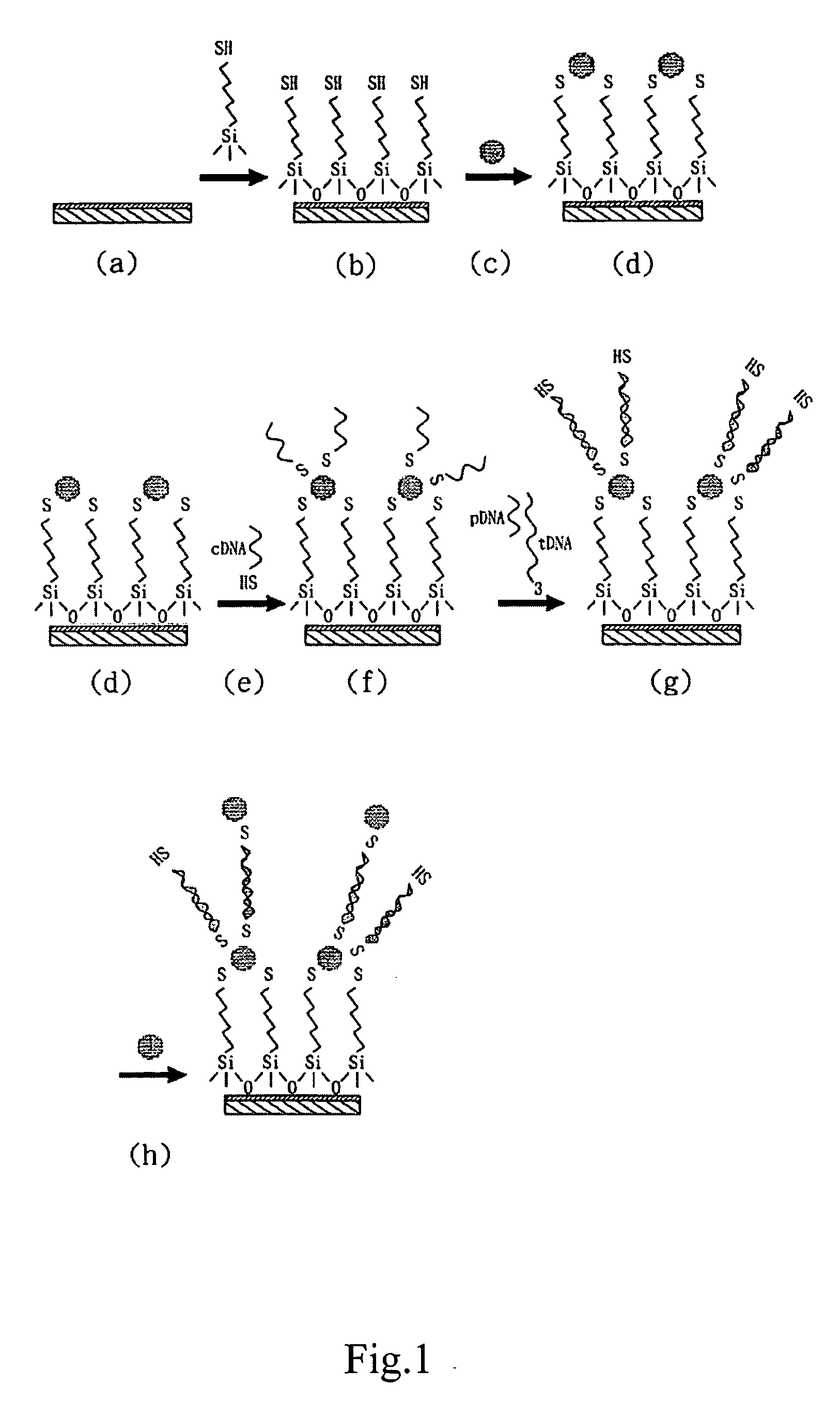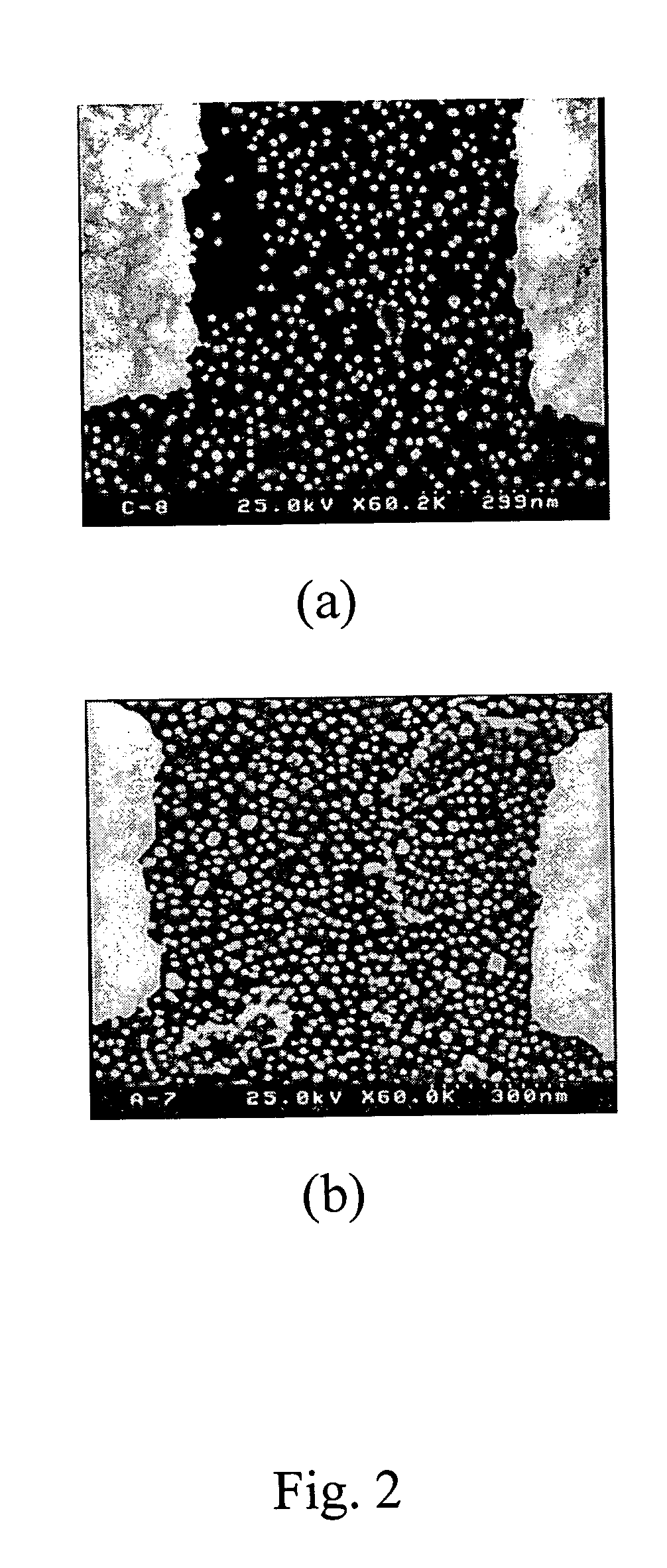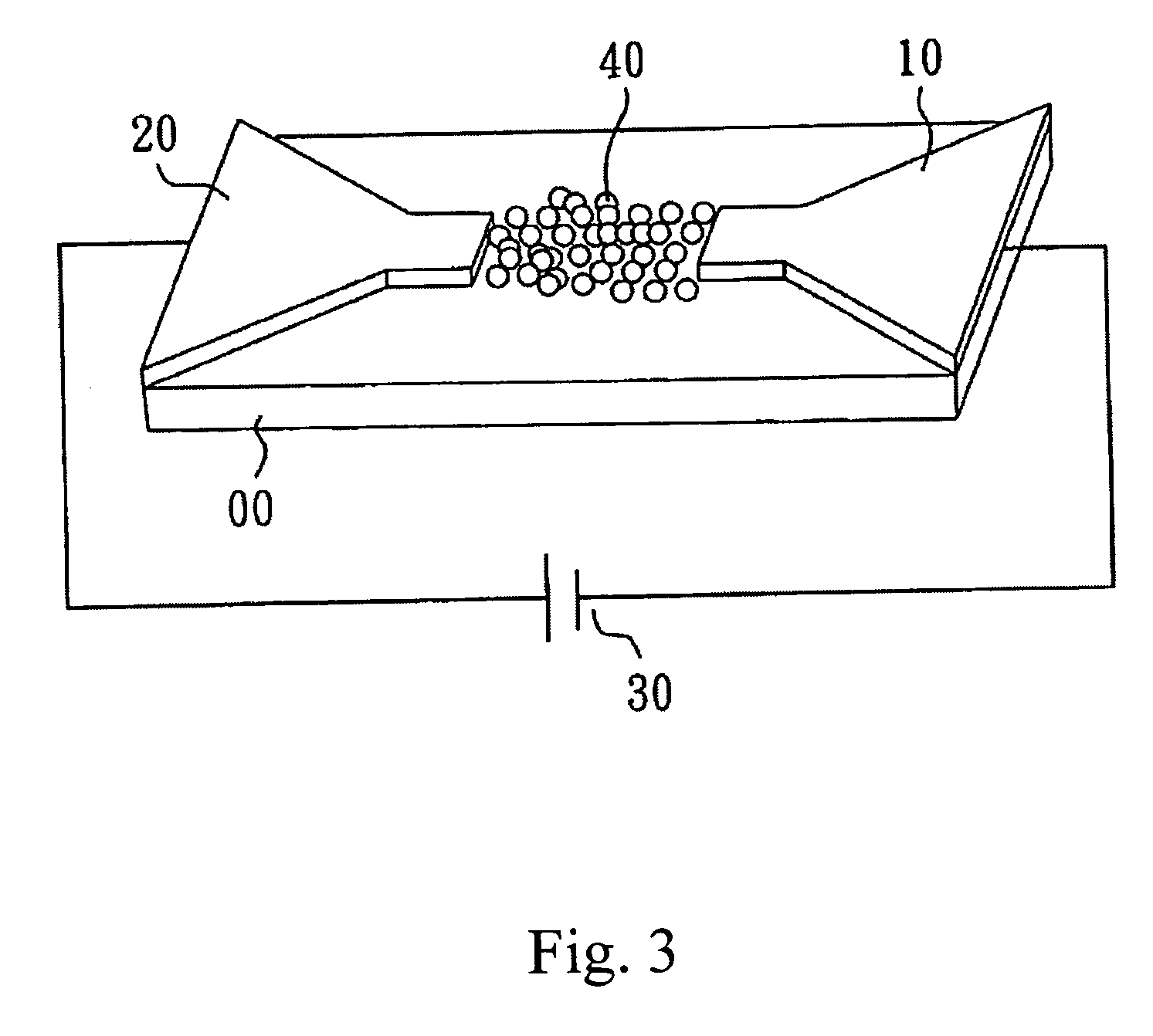Method for electrically detecting oligo-nucleotides with nano-particles
a nano-particle and nucleotide technology, applied in the field of electrically detecting oligo-nucleotides with nano-particles and electrodes, can solve the problems of increasing experiment time and further tasks, slowing the detection process, etc., and achieves the effect of short time and high sensitivity
- Summary
- Abstract
- Description
- Claims
- Application Information
AI Technical Summary
Benefits of technology
Problems solved by technology
Method used
Image
Examples
example 1
Substrate Activation and Monolayer of Gold Particles Formation
[0027] In reference to FIG. 1(a), a substrate mounted with two electrodes is provided, and the gap between the two electrodes is 300-600 nm.
[0028] Immerse the substrate into a solution with equal volume of concentrate sulfuric acid and methanol for 30 minutes, and wash the substrate. Rinse the substrate with non-ionic water (over 18 ΩW cm). Immerse the substrate into concentrate sulfuric acid for 5 minutes and wash it with water again. Place the substrate in boiled non-ionic water for several minutes and begin the procedures of substrate activation.
[0029] Prepare 1 mM solution of 3-Mercaptopropyl trimethoxysilane (Sigma Chemical Co.) with DMSO. Immerse the substrate into the solution for at least 2 hours at room temperature, rinse the substrate with DMSO and dry in the environment of nitrogen (FIG. 1(b)). Immerse the activated substrate into nano-gold particles solution (AuNPs) for 8-12 hours (FIG. 1(c)), wash the subs...
example 2
Immobilizaton and Hybridizaiton of Oligo-Nucleotides
[0031] Four oligo-nucleotide fragments are designed for the example: capture oligonucleotide (cDNA) as seen in SEQ ID NO. 1; target oligonucleotide (tDNA) as seen in SEQ ID NO. 2; probe oligonucleotide (PDNA) as seen in SEQ ID NO. 3; and single base mismatched target oligonucleotide (m-tDNA) as seen in SEQ ID NO. 4. Wherein, cDNA fragment and pDNA fragment both have a portion which is complementary to a different portion of tDNA.
[0032] In reference to table 1, four fragments are shown with sequences. Nucleotide bases with underlines indicate a complementary portion, and the single base with frame indicates a single base mutant, which leads to mis-match.
TABLE 1Oligo-nucleotidesSequencecDNA3′-HS-A10-CCT AAT AAC AAT-5′tDNA5′GGA TTA TG TTA AAT ATT GAT AAGGAT-3′m-tDNA5′GGA TTA TG TTA AAT ATT GAT AAGGAT-3′pDNA3′-TTA TAA CTA TTC CTA-A10-SH-5′
[0033] In reference to FIG. 1(e), 100 μl of 1 μM cDNA is deaerated with pH 6.6 HEPES(4-(2-hydr...
example 3
Results
[0037]FIG. 3 shows the device to measure the electrical characteristics on the substrate. A source 10, a drain 20 and a voltage generator 30 are on the substrate 00. When the voltage generator 30 provides a voltage, AuNPs 40 with hybridized oligo-nucleotides gather in the nano-gap of two electrodes 10, 20. Because of the conductivity of gold, the changing electrical behavior is measured. Based on the results, when no AuNPs 40 attach to the nano-gap of two electrodes 10, 20, the current measured is less than 50 mA.
[0038]FIG. 4 (a) shows the current-voltage curves for monolayer of gold particles, scan rate 10 mV / s; (b) shows current-voltage curves for multilayer (hybridization successful) of gold particles, scan rate 10 mV / s. Electrons tunnel more readily through the junction when enough energy is supplied. The linear curve is typical of ohmic devices.
[0039]FIG. 5 shows the I-V curves of the nano-gap electrode measured by using four different concentrations of tDNA: (A) 0.1 ...
PUM
| Property | Measurement | Unit |
|---|---|---|
| diameter | aaaaa | aaaaa |
| diameter | aaaaa | aaaaa |
| current | aaaaa | aaaaa |
Abstract
Description
Claims
Application Information
 Login to View More
Login to View More - R&D
- Intellectual Property
- Life Sciences
- Materials
- Tech Scout
- Unparalleled Data Quality
- Higher Quality Content
- 60% Fewer Hallucinations
Browse by: Latest US Patents, China's latest patents, Technical Efficacy Thesaurus, Application Domain, Technology Topic, Popular Technical Reports.
© 2025 PatSnap. All rights reserved.Legal|Privacy policy|Modern Slavery Act Transparency Statement|Sitemap|About US| Contact US: help@patsnap.com



